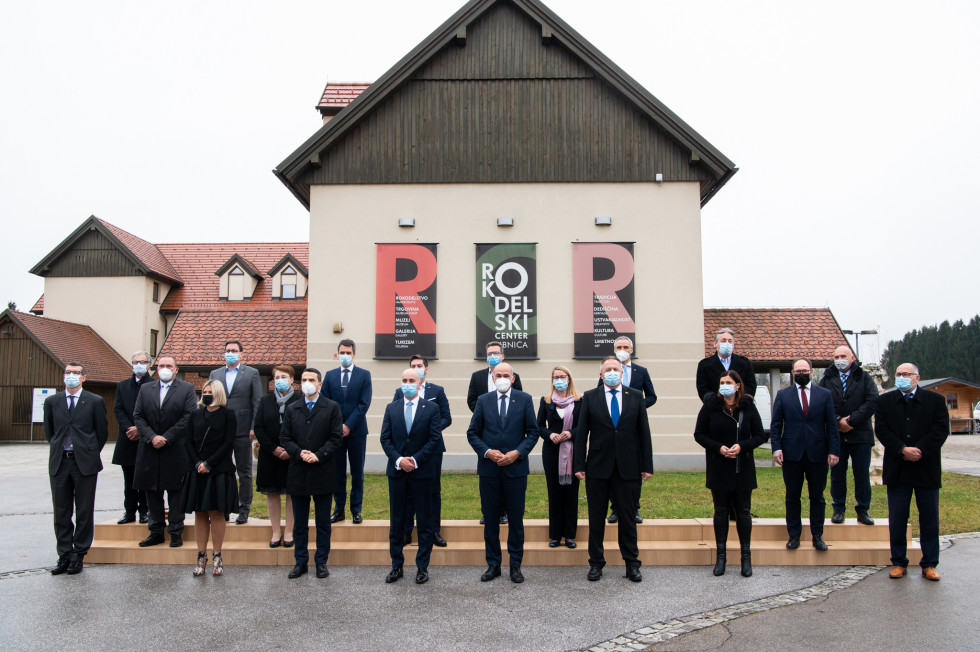By: UKOM
On Friday the Slovenian Government visited the South-East Slovenia (Jugovzhodna Slovenija) region, which comprises the municipalities of Črnomelj, Dolenjske Toplice, Kočevje, Kostel, Loški Potok, Metlika, Mirna, Mirna Peč, Mokronog – Trebelno, Novo mesto, Osilnica, Ribnica, Semič, Sodražica, Straža, Šentjernej, Šentrupert, Škocjan, Šmarješke Toplice, Trebnje and Žužemberk.
South-East Slovenia is divided geographically and sociologically into Dolenjska, Bela Krajina and Kočevsko-ribniško. It is the largest region in terms of area, spanning 2,675 km2, with 3/4 of its surface covered with forest. South-East Slovenia has a very favourable location in connection with neighbouring countries, with seven capital cities within a radius of 500 km and two major ports within 200 km, which makes the region economically open and accessible. The region has the advantage of a globally oriented economy, a good geographical location and natural resources, while its main disadvantage is its high dependence on large companies. South-East Slovenia ranks third among all Slovenian regions in terms of its level of development, taking into account the Development Risk Index (DRI), just behind the Central Slovenia (Osrednjeslovenska) and Gorenjska regions. The region has a strong export orientation, one of the lowest unemployment rates and the highest share of R&D expenditure in GDP among the Slovenian regions (4.4%). It boasts a rich industrial tradition, which has made a significant contribution to the development of the region as a whole. The region’s flagship companies include Krka, Revoz, Akrapovič, Adria Mobil, Terme Krka, Trimo, Dana, Kolpa, HYB, Riko, Mikrografija, and Yaskawa. The region’s overdependence on large companies does present an opportunity to promote the development of small and medium-sized enterprises.
The ministerial delegation first met for a working consultation in Ribnica, where the government representatives were welcomed by the Mayor of Ribnica, Samo Pogorelc. In his address, the Mayor of Ribnica thanked the Government for paying attention to municipalities. He highlighted in particular the higher per capita payment for municipalities and the fact that the Government had recognised the importance of municipalities. “What I missed in previous governments was this effectiveness and the awareness that it is the mayors and municipalities who make money and resources work for the people,” said Pogorelc. He also thanked the Government for the negotiated grants and expressed the hope that it would be willing to listen on the subject of co-financing shares. “I am glad that we have such an effective government,” the Mayor of Ribnica added.
At the working consultation, the ministers spoke mainly about projects in the region relating to long-term care, justice, cohesion and EU funds, economic opportunities, education, culture, home affairs, agriculture, healthcare and administrative services. The government has paid considerable attention to infrastructure projects, illegal migration, Roma issues and digitalisation. A call for a public tender for the construction of next-generation open broadband networks (GOŠO 5) is currently underway. In South-East Slovenia, 1,869 “white spots” (areas without internet access) have been identified and more than 60% of them with be covered with GOŠO 5.
After a working consultation, Prime Minister Janša visited KEKO–OPREMA in Žužemberk, where he met with the company’s management and spoke about the challenges facing the company in the context of the coronavirus crisis. He then met with the management of Krka in Novo mesto and continued his visit at the Novo mesto diocese, where he met with Bishop Msgr Dr Andrej Sajet.
KEKO–OPREMA in Žužemberk is engaged in the production and development of materials and equipment for multi-layer based electronic components production (MLCC, VDR, LTCC, chip inductors, EMI filters, etc.), other equipment for the production of electronic components and custom-made equipment for process automation. Today, the company’s philosophy is shaped by a team of highly motivated engineers and designers. The management of KEKO–OPREMA, which focuses mainly on global markets, highlighted the problems in the supply of microchips and the importance of an adequately qualified workforce. As part of the visit, the Prime Minister also met with the Mayor of Žužemberk, Jože Papež, with whom he discussed the issue of water supply in the municipality and important infrastructure projects. After the visit to the company, the Prime Minister was welcomed by representatives of the Suha krajina Peasant Women’s Association, who donated him a potica made by their own skilled hands.
In the continuation of his visit, Prime Minister Janez Janša met with the President of the Management Board of Krka, Jože Colarič. They discussed Krka’s business operations.
At the Novo mesto diocese, the Prime Minister met with Bishop Msgr Dr Andrej Sajet and his colleagues. The meeting was devoted to a discussion on the functioning of the diocese, the diocese’s plans for the future and the Catholic church in Slovenia.
The Prime Minister concluded his regional visit with a public forum on the development of the region of South-East Slovenia.
Source: gov.si

